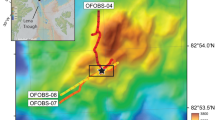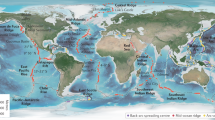Abstract
Twenty years after the discovery of sea-floor hot springs, vast stretches of the global mid-ocean-ridge system remain unexplored for hydrothermal venting. The southwest Indian ridge is a particularly intriguing region, as it is both the slowest-spreading of the main ridges1 and the sole modern migration pathway between the diverse vent fauna of the Atlantic and Pacific oceans2. A recent model postulates that a linear relation exists between vent frequency and spreading rate3 and predicts vent fields to be scarcest along the slowest-spreading ridge sections, thus impeding migration and enhancing faunal diversity2. Here, however, we report evidence of hydrothermal plumes at six locations within two 200-km-long sections of the southwest Indian ridge indicating a higher frequency of venting than expected. These results suggest that fluxes of heat and chemicals from slow-spreading ridges may be greater than previously thought and that faunal migration along the southwest Indian ridge may serve as an important corridor for gene-flow between Pacific and Atlantic hydrothermal fields.
This is a preview of subscription content, access via your institution
Access options
Subscribe to this journal
Receive 51 print issues and online access
$199.00 per year
only $3.90 per issue
Buy this article
- Purchase on Springer Link
- Instant access to full article PDF
Prices may be subject to local taxes which are calculated during checkout



Similar content being viewed by others
References
DeMets, C., Gordon, R. G., Argus, D. F. & Stein, S. Current plate motions Geophys. J. Int. 101, 425–478 (1990).
Tunnicliffe, V. & Fowler, C. M. R. Influence of seafloor spreading on the global hydrothermal vent fauna. Nature 379, 531–533 (1996).
Baker, E. T., Chen, Y. J. & Phipps Morgan, J. The relationship between near-axis hydrothermal cooling and the spreading rate of mid-ocean ridges. Earth Planet. Sci. Lett. 142, 137–145 (1996).
Lupton, J. E., Delaney, J. R., Johnson, H. P. & Tivey, M. K. Entrainment and vertical transport of deep ocean water by buoyant hydrothermal plumes. Nature 316, 621–623 (1985).
Feely, R. A. et al. Composition and dissolution of black smoker particulates from active vents on the Juan de Fuca Ridge. J. Geophys. Res. 92, 11347–11365 (1987).
Baker, E. T., German, C. R. & Elderfield, H. Hydrothermal Plumes over Spreading-center Axes: Global Distributions and Geophysical Inferences 47–71 (AGU Monogr. 91, Am. Geophys. Union, Washington DC, 1995).
Langmuir, C. H. et al. Investigation of the Southwest Indian Ridge: A Project Plan (InterRidge SWIR Project Plan, InterRidge, Paris, 1997).
German, C. R., Parson, L. M. & the HEAT Scientific Team.Hydrothermal exploration near the Azores triple-junction: tectonic control of venting at slow-spreading ridges? Earth Planet. Sci. Lett. 138, 93–10 1996).
Tamaki, K. & Mevel, C. FUJI (French–UK–Japan InterRidge) Cruise: R/V Marion Dufresne, Durban—la Reunion (ORI Cruise Rep., Ocean Res. Inst., Tokyo, 1997).
Baker, E. T. & Milburn, H. B. MAPR: A new instrument for hydrothermal plume mapping. Ridge Events 8, 23–25 (1997).
Feely, R. A. et al. Hydrothermal plume particles and dissolved phosphate over the superfast spreading southern East Pacific Rise. Geochim. Cosmochim. Acta 60, 2297–2323 (1996).
Rona, P. A. & Scott, S. D. Aspecial isue on sea-floor hydrothermal mineralization: new perspectives. Econ. Geol. 88, 1935–1976 (1993).
Plüger, W. L. et al. Discovery of hydrothermal fields at the Central Indian Ridge. Mar. Mining 9, 73–86 (1990).
Gamo, T. Hydrothermal plumes at the Rodriguez triple junction, Indian Ridge. Earth Planet. Sci. Lett. 142, 261–270 (1996).
Scheirer, D. S., Baker, E. T. & Johnson, K. T. M. Detection of hydrothermal plumes along the Southeast Indian Ridge near the Amsterdam–St. Paul Plateau. Geophys. Res. Lett. 25, 97–100 (1998).
German, C. R., Baker, E. T. & Klinkhammer, G. Regional Setting of Hydrothermal Activity (Spec. Publ. 87, Geol. Soc., London, 1995).
Elderfield, H. & Schulz, A. Mid-Ocean Rdige hydrothermal fluxes and the chemical composition of the ocean. Annu. Rev. Earth Planet. Sci. 24, 191–224 (1996).
Palmer, M. R. & Ernst, G. G. Generation of hydrothermal megaplumes by cooling of pillow basalts at mid-ocean ridges. Nature 393, 643–647 (1998).
Acknowledgements
We thank S. Walker (NOAA/PMEL) for her assistance in development of the MAPR instruments and the Captain, crew and IFRTP team of the RV Marion Dufresne who contributed to the success of this project. The FUJI cruise was co-funded by IFRTP (France) and The Grant-in-Aid for Scientific Research from the Ministry of Education, Science, Sports, and Culture (Japan). TOBI support was funded through the EC TMR Grant: European Access to Seafloor Survey Systems (EASSS) whilst hydrothermal research was supported by NERC and the SOC (UK) and by the NOAA-Vents program (USA).
Author information
Authors and Affiliations
Corresponding author
Rights and permissions
About this article
Cite this article
German, C., Baker, E., Mevel, C. et al. Hydrothermal activity along the southwest Indian ridge. Nature 395, 490–493 (1998). https://doi.org/10.1038/26730
Received:
Accepted:
Issue Date:
DOI: https://doi.org/10.1038/26730
This article is cited by
-
Volcanic evolution of an ultraslow-spreading ridge
Nature Communications (2023)
-
Geological context and vents morphology in the ultramafic-hosted Tianxiu field, Carlsberg Ridge
Acta Oceanologica Sinica (2023)
-
Volcanically hosted venting with indications of ultramafic influence at Aurora hydrothermal field on Gakkel Ridge
Nature Communications (2022)
-
Indian Ocean Ridge System and Seafloor Hydrothermal Activity
Journal of the Geological Society of India (2022)
-
Geological characteristics of the Qiaoyue Seamount and associated ultramafic-hosted seafloor hydrothermal system (∼52.1°E, Southwest Indian Ridge)
Acta Oceanologica Sinica (2021)
Comments
By submitting a comment you agree to abide by our Terms and Community Guidelines. If you find something abusive or that does not comply with our terms or guidelines please flag it as inappropriate.



